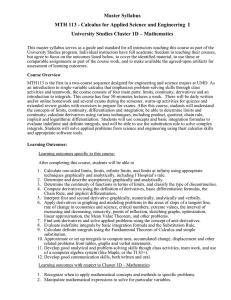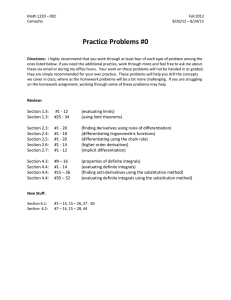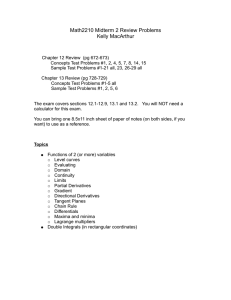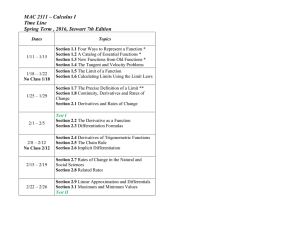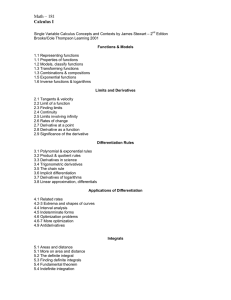Master Syllabus MTH 111 – Analytical Geometry and Calculus I
advertisement
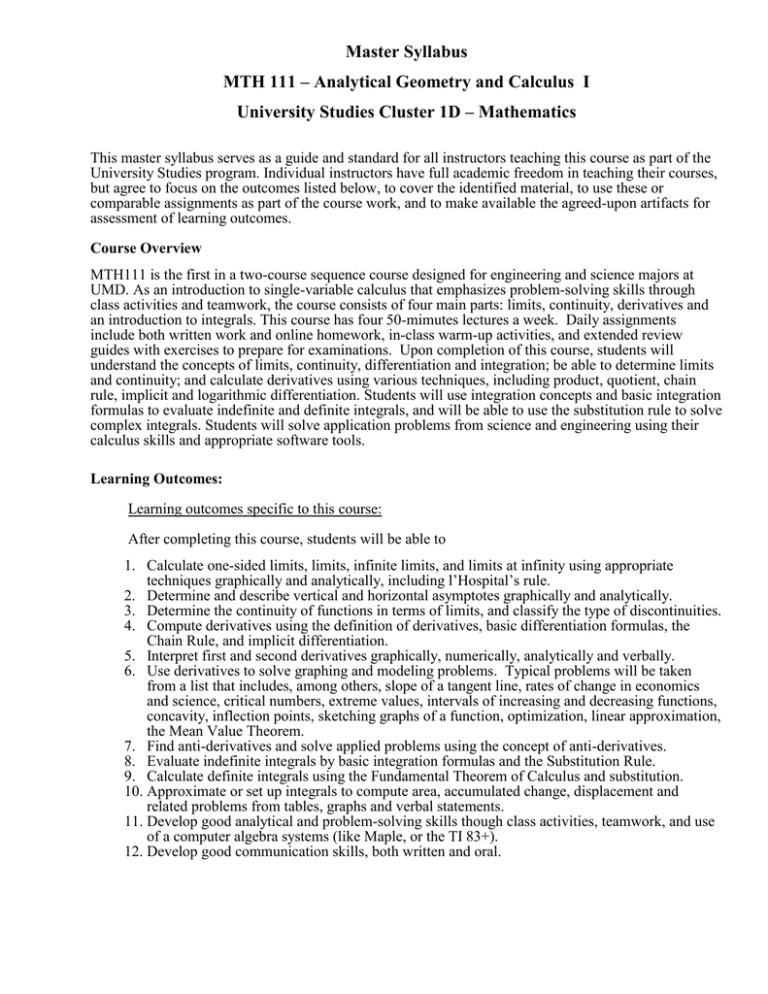
Master Syllabus MTH 111 – Analytical Geometry and Calculus I University Studies Cluster 1D – Mathematics This master syllabus serves as a guide and standard for all instructors teaching this course as part of the University Studies program. Individual instructors have full academic freedom in teaching their courses, but agree to focus on the outcomes listed below, to cover the identified material, to use these or comparable assignments as part of the course work, and to make available the agreed-upon artifacts for assessment of learning outcomes. Course Overview MTH111 is the first in a two-course sequence course designed for engineering and science majors at UMD. As an introduction to single-variable calculus that emphasizes problem-solving skills through class activities and teamwork, the course consists of four main parts: limits, continuity, derivatives and an introduction to integrals. This course has four 50-mimutes lectures a week. Daily assignments include both written work and online homework, in-class warm-up activities, and extended review guides with exercises to prepare for examinations. Upon completion of this course, students will understand the concepts of limits, continuity, differentiation and integration; be able to determine limits and continuity; and calculate derivatives using various techniques, including product, quotient, chain rule, implicit and logarithmic differentiation. Students will use integration concepts and basic integration formulas to evaluate indefinite and definite integrals, and will be able to use the substitution rule to solve complex integrals. Students will solve application problems from science and engineering using their calculus skills and appropriate software tools. Learning Outcomes: Learning outcomes specific to this course: After completing this course, students will be able to 1. Calculate one-sided limits, limits, infinite limits, and limits at infinity using appropriate techniques graphically and analytically, including l’Hospital’s rule. 2. Determine and describe vertical and horizontal asymptotes graphically and analytically. 3. Determine the continuity of functions in terms of limits, and classify the type of discontinuities. 4. Compute derivatives using the definition of derivatives, basic differentiation formulas, the Chain Rule, and implicit differentiation. 5. Interpret first and second derivatives graphically, numerically, analytically and verbally. 6. Use derivatives to solve graphing and modeling problems. Typical problems will be taken from a list that includes, among others, slope of a tangent line, rates of change in economics and science, critical numbers, extreme values, intervals of increasing and decreasing functions, concavity, inflection points, sketching graphs of a function, optimization, linear approximation, the Mean Value Theorem. 7. Find anti-derivatives and solve applied problems using the concept of anti-derivatives. 8. Evaluate indefinite integrals by basic integration formulas and the Substitution Rule. 9. Calculate definite integrals using the Fundamental Theorem of Calculus and substitution. 10. Approximate or set up integrals to compute area, accumulated change, displacement and related problems from tables, graphs and verbal statements. 11. Develop good analytical and problem-solving skills though class activities, teamwork, and use of a computer algebra systems (like Maple, or the TI 83+). 12. Develop good communication skills, both written and oral. Learning outcomes with respect to Cluster 1D – Mathematics 1. Recognize when to apply mathematical concepts and methods to specific problems. 2. Manipulate mathematical expressions to solve for particular variables. 3. Draw conclusions from quantitative information and communicate these conclusions verbally and graphically. 4. Implement mathematical models to obtain accurate or approximate solutions using appropriate tools. 5. Apply mathematical techniques to social and scientific problems. Textbook: Stewart, J., Calculus — Early Transcendental Functions, 7E, Belmont, CA: Brooks/Cole, 2012. Homework Assignments: Students will apply learned course material to complete assigned homework as listed in the syllabus. Assignments may be both online and paper-based. Students are expected to submit homework neatly and timely. Quizzes: There will be several 15 minute quizzes. Tests: There are three in-class tests, where students will apply knowledge and skills from the corresponding chapters to solve problems. The following Applications of Differentiation Test is designed to see the extent to which students have the computational and quantitative reasoning skills required to apply differentiation techniques to a variety of problems. Students are required to show complete work to support their final answer; calculators are allowed, and one formula sheet may also be used at the discretion of the instructor. The following map indicates which problems are associated with each of the five Gen Ed learning outcomes in mathematics. Suggested solutions and partial points for problem 3 are attached. The degree of success achieved for each learning outcome is measured by the average percentage correct. University Studies Outcome Problems Points (Total 100) Recognize when to apply mathematical concepts and methods to specific problems. 1,4 20 Manipulate mathematical expressions to solve for particular variables. 3 20 Draw conclusions from quantitative information and communicate these conclusions verbally and graphically. 5 25 Implement mathematical models to obtain accurate or approximate solutions using appropriate tools. 6 25 Apply mathematical techniques to social and scientific problems. 2 10 Final Exam: The final exam will be cumulative, but weigh more heavily on material presented towards the end of the term. Course Outline Week 1 Week 2-3 Week 4 Week 5 Week 6 Week 7 Week 8 Week 9 Week 10 Week 11 Week 12 Week 13 Week 14 Week 15 Chapter 1 Chapter 1-2 Chapter 2 Chapter 2 Chapter 3 Chapter 3 Chapter 3 Chapter 4 Chapter 4 Chapter 4 Chapter 4-5 Chapter 5 Chapter 5 Review Review: Functions and Models The Limit of a Function Continuity, Limits at Infinity, Asymptotes Derivatives, the Derivatives as a Function Basic Differential Rules, the Chain Rule Implicit Differentiation, Derivatives of Logarithmic Functions Linear Approximations and Differentials, Related Rates Application: Maximum and Minimum, the Mean Value Theorem The First and Second Derivatives, Curve Sketching, L’Hospital’s Rule Optimization Problems, Newton’s Method Antiderivatives, Indefinite Integrals, Definite Integral, Areas, Distance, and the Net Change Theorem Integration By Substitution

